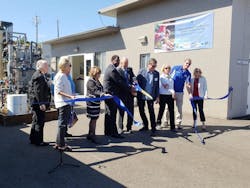Demonstrating Reuse
Bob Crossen is managing editor for WWD. Crossen can be reached at [email protected].
Among the states in the western U.S., California is one of the most progressive when it comes to advancing water reuse methods. The Orange County Water district, for instance, has been using reuse in some fashion at its facilities since the 1970s to recharge groundwater supplies.
And this year, IDE Technologies debuted the Central Coast Blue Advanced Water Purification Demonstration Facility in Pismo Beach, Calif., directed at furthering the water reuse cause in the face of extended droughts and increasing water scarcity in the southwestern U.S.
The Pismo Beach demonstration facility uses the company’s EcoReuse technology, which eliminates the need to introduce chloramines at the front of the treatment process. Gilad Cohen, CEO for IDE Technologies, said this helps avoid the formation of contaminants and saves on overall energy costs in the reverse osmosis and ultraviolet disinfection systems.
“We came up with a new process and demonstrated that we can work with a reduced amount of chemicals by avoiding the chloramination and with reduced energy,” Cohen said.
Stepping Through Treatment
The Pismo Beach demonstration facility takes effluent from the secondary treatment phase and sends it through a micro-filtration system without chlorinating the water. The effluent then passes through an RO system to reduce the salinity level and to provide another layer of protection in the treatment process. From there, ultraviolet light is used to disinfect the water.
“Unlike the standard process that does have to add the chloramine,” Cohen said, “this is a UV system that works a little bit more in a relaxed mode, which means lower doses, which means lower energy, and provides the level of treatment that is still required in order to process the water for a potable level of usage afterwards.”
The Pismo Beach facility is only one configuration that Cohen said has been demonstrated. The Regional Recycled Water Advanced Purification Center demonstration facility, conducted in partnership with the Metropolitan Water District of Southern California and the Sanitation Districts of Los Angeles, collects wastewater like the Central Blue Coast facility, but sends it into a membrane bioreactor before passing it through RO and UV systems. This reactor is used to treat the biological overload, Cohen said.
Intentional Outreach
Cohen said these two demonstration facilities are part of a larger effort to encourage wastewater reuse in the U.S. California, Arizona and Texas allow reuse to different degrees as a water scarcity strategy. Cohen said the biggest hurdle in taking wastewater reuse mainstream is public opinion.
“It is a resource that is sitting there, and the technology is available. It’s a matter of building the confidence and assurance to ourselves, to the public, to lawmakers and making sure we’re doing it in a safe and viable way,” Cohen said. “There’s no reason not to turn it into another source of water.”
While the general public is still hesitant about treating wastewater for potable use, Cohen said demonstration facilities and technology showcases have begun to make an impact. The public is asking more questions about how these systems work, and while many still keep it at arm’s reach, the idea of wastewater reuse is not as vehemently off-putting as it once was.
“There are still questions, and I think those questions are valid and important and they should be answered,” Cohen said. “But gradually we see the public growing confidence in water reuse
in California.”
